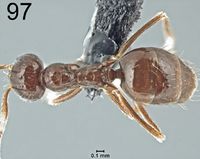Prenolepis mediops
| Prenolepis mediops | |
|---|---|

| |
| Scientific classification | |
| Kingdom: | Animalia |
| Phylum: | Arthropoda |
| Class: | Insecta |
| Order: | Hymenoptera |
| Family: | Formicidae |
| Subfamily: | Formicinae |
| Tribe: | Lasiini |
| Genus: | Prenolepis |
| Species: | P. mediops |
| Binomial name | |
| Prenolepis mediops Williams & LaPolla, 2016 | |
Nothing is known about the biology of Prenolepis mediops.
Identification
Williams and LaPolla (2016) - In profile view, propodeum is obtusely angled with a flat dorsal face; compound eyes moderately sized, rounded, and spaced far apart (REL3 < 40).
This species is most similar to Prenolepis shanialena, but is distinguished by its moderately sized compound eyes, which are distinctly smaller and spaced farther apart than those of most other Prenolepis species. The only other Prenolepis species with compound eyes comparable in relative size and position is Prenolepis melanogaster, which is a much larger species (TL > 4.25mm) that has a yellow-brown head and mesosoma and a dark brown to black gaster.
Keys including this Species
Distribution
Latitudinal Distribution Pattern
Latitudinal Range: 27.715° to 27.715°.
| North Temperate |
North Subtropical |
Tropical | South Subtropical |
South Temperate |
- Source: AntMaps
Distribution based on Regional Taxon Lists
Palaearctic Region: China (type locality).
Distribution based on AntMaps
Distribution based on AntWeb specimens
Check data from AntWeb
Countries Occupied
| Number of countries occupied by this species based on AntWiki Regional Taxon Lists. In general, fewer countries occupied indicates a narrower range, while more countries indicates a more widespread species. |

|
Estimated Abundance
| Relative abundance based on number of AntMaps records per species (this species within the purple bar). Fewer records (to the left) indicates a less abundant/encountered species while more records (to the right) indicates more abundant/encountered species. |

|
Biology
Castes
Nomenclature
The following information is derived from Barry Bolton's Online Catalogue of the Ants of the World.
- mediops. Prenolepis mediops Williams & LaPolla, 2016: 231, figs 95-97 (w.) CHINA.
Unless otherwise noted the text for the remainder of this section is reported from the publication that includes the original description.
Description
Worker
(n=3): CMC: 11–12; EL: 0.18–0.19; EW: 0.15–0.16; HL: 0.70–0.76; HLA: 0.35–0.39; HLP: 0.26–0.28; HW: 0.67–0.70; IOD: 0.47–0.50; LF1: 0.19; LF2: 0.08–0.09; LHT: 0.82–0.89; MMC: 2–3; MTW: 0.39–0.42; MW: 0.24–0.28; PDH: 0.29–0.31; PMC: 3–4; PrCL: 0.41–0.44; PrCW: 0.23–0.24; PrFL: 0.66–0.71; PrFW: 0.15–0.16; PTH: 0.31; PTL: 0.29–0.31; PTW: 0.24–0.26; PW: 0.44–0.47; SL: 0.84–0.87; TL: 2.85–3.32; WF1: 0.07; WF2: 0.06–0.07; WL: 0.91–1.00; BLI: 130–142; CI: 92–96; EPI: 127–147; FLI: 200– 235; HTI: 123–127; PetHI: 100–107; PetWI: 83–84; PrCI: 53–55; PrFI: 22–23; REL: 25–26; REL2: 27; REL3: 38–39; SI: 124–126.
Light to medium brown; antennae and mandibles distinctly much lighter in color when rest of body is medium brown; cuticle of head, pronotum, and propodeum smooth and shiny; cuticle of gaster lightly reticulate; abundant decumbent setae on scapes and legs; long, erect macrosetae on head, pronotum, mesonotum, and gaster; head about as long as broad and round in shape with indistinct posterolateral corners and a straight posterior margin; compound eyes moderately sized, convex, and spaced far apart (REL3 < 40); compound eyes do not surpass the lateral margins of the head in full-face view; torulae overlap with the posterior border of the clypeus; clypeus with prominent anterolateral lobes; mandibles with 6 teeth on the masticatory margin; ectal surface of mandibles with light longitudinal striations; in profile view, propodeum is obtusely angled with a flat dorsal face; dorsal apex of petiole scale is sharply angled and forward-inclined.
Type Material
Holotype worker. China: Yunnan Province, Gaoli-gong Shan, Nujiang State Nat. Res., 27.715°N 98.565°E, 2000m, 09– 14.vii.2000 (D.H. Kavanaugh, C.E. Griswold, D. Ubick, H.M. Yan, D.Z. Dong, H.B. Liang) (National Museum of Natural History: CASENT0203583). 2 paratype workers, same locality as holotype (USNM: CASENT0203584, CASENT0203585).
Etymology
The specific epithet is named for the moderately sized compound eyes of this species.
References
- Liu, C., Fischer, G., Hita Garcia, F., Yamane, S., Liu, Q., Peng, Y.Q., Economo, E.P., Guénard, B., Pierce, N.E. 2020. Ants of the Hengduan Mountains: a new altitudinal survey and updated checklist for Yunnan Province highlight an understudied insect biodiversity hotspot. ZooKeys 978, 1–171 (doi:10.3897/zookeys.978.55767).
- Williams, J. L. and J. S. LaPolla. 2016. Taxonomic revision and phylogeny of the ant genus Prenolepis (Hymenoptera: Formicidae). 4200(2):201–258. doi:10.11646/zootaxa.4200.2.1
- Williams, J.L. 2022. Description of Prenolepis rinpoche sp. nov. from Nepal, with discussion of Asian Prenolepis species biogeography. Asian Myrmecology 15, e015008 (doi:10.20362/am.015008).

